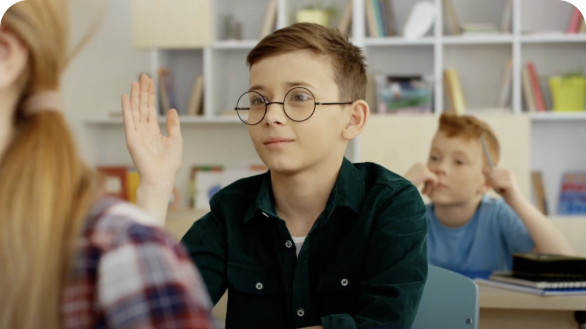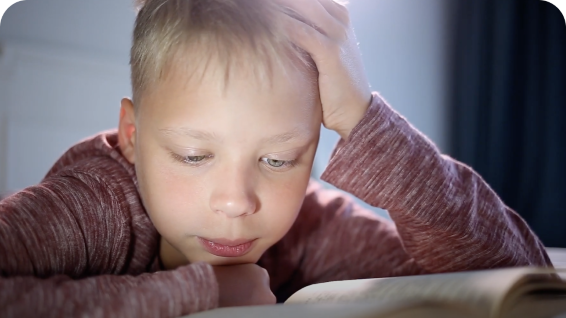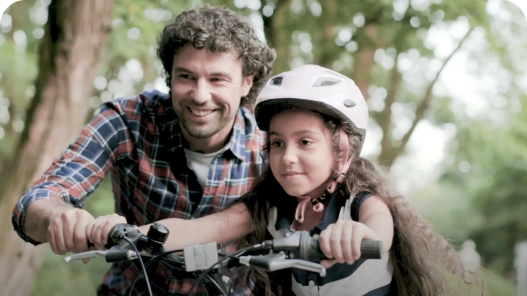Frequently Asked Questions
Resources
Browse answers to common questions and watch helpful videos. As the number of children affected by myopia grows, so does our understanding of it. Staying informed is key to taking charge of myopia. That’s why we’ve put together some of the most frequently asked questions we hear. Below are the answers that may help you care for your child or yourself.
Jump to:
Myopia 101
About Myopia
What are the signs and symptoms of myopia?
What causes myopia in children?
Does myopia worsen with age in children?
How do astigmatism and myopia differ?
What is high myopia?
Can myopia be reversed or cured?
Can myopia lead to blindness?
Eye Exams
Questions About Eye Exams
What’s the difference between vision screening performed at school or the pediatrician’s office versus a comprehensive eye exam?
How often should my child have an eye exam?
Where can I get my child screened for myopia?
What should I expect from a myopia eye exam?
What are some common eye health words I may hear during the eye exam?
Managing Myopia
How Can I Manage Myopia?
Can sunlight or vitamin D help prevent or slow myopia?
Can reduced screen time cure or reduce myopia?
Can eye exercises/vision therapy cure myopia?
Can under-correcting myopia (providing less prescription than recommended) help myopia? I’ve heard giving glasses to my child will make their eyes worse over time.
Can LASIK treat or cure my myopia?
Do regular glasses and contacts help or hurt myopia? What’s the difference between vision correction and myopia management?
Are there treatments available for myopia?
Will I see better with myopia management treatment options?
Do I still need to change my child’s prescription when undergoing myopia management?
When should myopia management start?
Are there age restrictions on myopia management? Is my child too young or too old?
How long will I need myopia management for?
Are there side effects with myopia management?
What can I do around the house to help manage my kid’s myopia?
References:
1. Chua SY, et al. Age of Onset of Myopia Predicts Risk of High Myopia in Later Childhood in Myopic Singapore Children. Opthal Physiol Opt. 2016;36:388-94.
2. Rudnicka AR, Kapetanakis VV, Wathern AK, et al. Global variations and time trends in the prevalence of childhood myopia, a systematic review and quantitative meta-analysis: implications for aetiology and early prevention. Br J Ophthalmol. 2016 Jul;100(7):882-890.
3. Tedja MS, et al. IMI - Myopia Genetics Report. Invest Ophthalmol Vis Sci. 2019;60:M89-M105.
4. Huang, et al. The Association between Near Work Activities and Myopia in Children: A Systematic Review and Meta-Analysis. PLoS One. 2015;10:e0140419.
5. Wen L, et al. Objectively measured near work, outdoor exposure and myopia in children. Br J Ophthalmol. Published Online First: 19 February 2020. doi: 10.1136/bjophthalmol-2019-315258.
6. French AN, Ashby RS, Morgan IG, Rose KA. Time Outdoors and the Prevention of Myopia. Experimental eye research. 2013;114:58-68.
7. Morgan IG, French AN, Ashby RS, et al. The Epidemics of Myopia: Aetiology and Prevention. Prog Retin Eye Res. 2018;62:134-49.
8. Xiong, et al. Time spent in outdoor activities in relation to myopia prevention and control: A meta-analysis and systematic review. Acta Ophthalmol. 2017 Sep;95(6):551-566.
9. Bullimore MA, Brennan NA. Myopia-control: Why Each Diopter Matters. Optom Vis Sci. 2019;96:463-5.
10. Wu PC, et al. Increased Time Outdoors Is Followed by Reversal of the Long-Term Trend to Reduced Visual Acuity in Taiwan Primary School Students. Ophthalmol. 2020 Feb 8:S0161-6420(20)30139-1.
11. American Optometric Association Comprehensive Pediatric Eye and Vision Examination Evidence-Based Clinical Practice Guidelines. 2017.
12. Systemic Conditions with Ocular and Visual Manifestations. American Optometric Association. December 2019.
13. Pärssinen O, Kauppinen M. Risk factors for high myopia: a 22-year follow-up study from childhood to adulthood. Acta Ophthalmologica. 2019;97(5):510-518.
14. Flitcroft DI. The complex interactions of retinal, optical and environmental factors in myopia aetiology. Prog Retin Eye Res. 2012;31(6):622-660.
15. World Health Organization The impact of Myopia and High Myopia - Report of the Joint World Health Organization -Brien Holden Vision Institute Global Scientific Meeting.
16. Wu PC, Chen CT, Lin KK, et al. Myopia Prevention and Outdoor Light Intensity in a School-Based Cluster Randomized Trial. Ophthalmol. 2018;125:1239-50.
17. Donovan L, Sankaridurg P, Ho A, et al. Myopia progression rates in urban children wearing single-vision spectacles. Optom Vis Sci. 2012;89(1):27-32.
18. Haarman AEG, Enthoven CA, Willem Tideman JL, Tedja MS, Verhoeven VJM, Klaver CCW. The complications of myopia: A review and meta-analysis. Invest Ophthalmol Vis Sci. 2020;61(4):49-49.
19. Sanchez-Tocino H, Villanueva Gomez A, Gordon Bolanos C, et al. The Effect of Light and Outdoor Activity in Natural Lighting on the Progression of Myopia in Children. J Fr Ophtalmol. 2019;42:2-10.
20. Ngo C, Saw S-M, Dharani R, Flitcroft I. Does sunlight (bright lights) explain the protective effects of outdoor activity against myopia? Opthal Physiol Opt. 2013;33(3):368-372. doi:10.1111/opo.12051.
21. Klaver C, Polling JR; Erasmus Myopia Research Group. Myopia management in the Netherlands. Opthal Physiol Opt. 2020 Mar;40(2):230-240. doi: 10.1111/opo.12676. PMID: 32202320.
22. Németh J, Tapasztó B, Aclimandos WA, Kestelyn P, Jonas JB, De Faber JHN, Januleviciene I, Grzybowski A, Nagy ZZ, Pärssinen O, Guggenheim JA, Allen PM, Baraas RC, Saunders KJ, Flitcroft DI, Gray LS, Polling JR, Haarman AE, Tideman JWL, Wolffsohn JS, Wahl S, Mulder JA, Smirnova IY, Formenti M, Radhakrishnan H, Resnikoff S. Update and guidance on management of myopia. European Society of Ophthalmology in cooperation with International Myopia Institute. Eur J Ophthalmol. 2021 May;31(3):853-883. doi: 10.1177/1120672121998960. Epub 2021 Mar 5. PMID: 33673740; PMCID: PMC8369912.
23. Kahmeng Chung, Norhani Mohidin, Daniel J. O’Leary, Undercorrection of myopia enhances rather than inhibits myopia progression, Vision Research, Volume 42, Issue 22, 2002, Pages 2555-2559, ISSN 0042-6989, https://doi.org/10.1016/S0042-6989(02)00258-4.
24. Kato N, Toda I, Hori-Komai Y, Sakai C, Tsubota K. Five-year outcome of LASIK for myopia. Ophthalmol. 2008 May;115(5):839-844.e2. doi: 10.1016/j.ophtha.2007.07.012. Epub 2007 Sep 27. PMID: 17900692.
25. Sharma N, Singhvi A, Sinha R, Vajpayee RB. Reasons for not performing LASIK in refractive surgery candidates. J Refract Surg. 2005 Sep-Oct;21(5):496-8. doi: 10.3928/1081-597X-20050901-13. PMID: 16209449.
26. Németh J, et al. Update and guidance on management of myopia. European Society of Ophthalmology in cooperation with International Myopia Institute. Eur J Ophthalmol. 2021 May;31(3):853-883. doi: 10.1177/1120672121998960. Epub 2021 Mar 5. PMID: 33673740; PMCID: PMC8369912.
PP2023OTH5558



